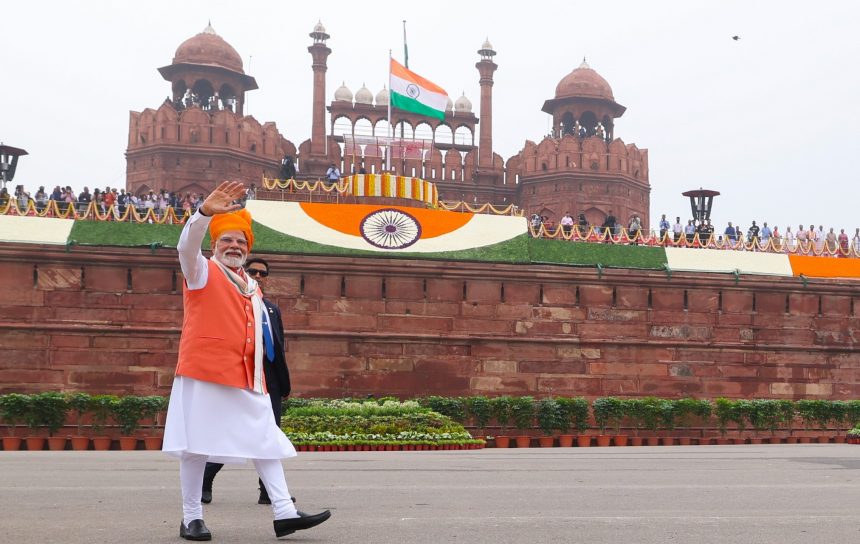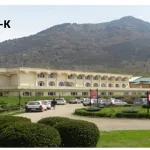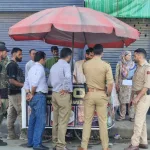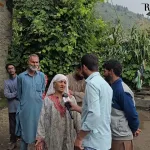Every Independence Day carries emotion, but this year’s 79th Independence Day felt especially powerful. Prime Minister Narendra Modi’s speech from the Red Fort was filled with pride in India’s journey, concern for the challenges we face, and above all, a call to shape the destiny of Bharat with self-reliance and unity. Listening to him, one could sense the weight of history and also the energy of the future. What stood out first was the way he described the atmosphere of the nation. From deserts to Himalayan peaks, from crowded cities to remote villages, the Tricolour was flying proudly. He connected that simple act of hoisting the national flag with a deep sense of unity, showing how 140 crore Indians are bound by a common love for the motherland.
The Prime Minister then bowed to the makers of the Constitution. His words reminded us that freedom is incomplete without the guiding principles of democracy. Names like Ambedkar, Rajendra Prasad, Nehru, Patel, and others were not just mentioned; they were celebrated for building a lighthouse that has guided India for 75 years. Importantly, he recalled the contributions of women like Hansa Mehta and Dakshayani Velayudhan, reminding us that India’s progress has always been inclusive.
Another strong theme was national integrity. By remembering Dr. Syama Prasad Mookerjee and his sacrifice, Modi placed the removal of Article 370 in the larger framework of “One Nation, One Constitution.” This was a fulfilment of a vision that India must remain united in spirit and in law. Yet the speech did not remain in history. It also reflected the present India—the “mini Bharat” visible at the Red Fort. From panchayat leaders to Drone Didis, from Lakhpati Didis to athletes, the audience itself represented the diversity and potential of the nation.
The part that struck me most deeply was his salute to the soldiers of Operation Sindoor. He spoke with raw honesty about the massacre at Pahalgam, where terrorists killed innocents in the most inhuman way. Instead of leaving that pain unanswered, the government gave the army full freedom, and the result was a decisive operation that shook Pakistan. This was a declaration that Bharat has changed the rules: terrorism and its sponsors will no longer be treated separately. Both will face the same fate.
The Prime Minister went even further, breaking an old taboo: the Indus Waters Treaty. For decades, India’s farmers have suffered while rivers watered fields across the border. His statement that “blood and water will not flow together” captured both anger and resolve. By signalling a review of this treaty, he reminded us that fairness must guide international agreements, and national interest cannot be ignored any longer.
The speech was not only about security and geopolitics. Its heartbeat was self-reliance—Atmanirbharta. He connected freedom itself with the ability to stand on our own feet. He reminded us that slavery had not only made us poor but had made us dependent, and that even after independence, dependency crept in quietly. To him, true dignity lies in not having to rely on others for essential needs.
He gave an example that felt very real: Operation Sindoor succeeded because the soldiers had “Made in India” weapons in their hands. Imagine, he said, what would have happened if we were dependent on foreign suppliers at that moment. His point was clear—self-reliance is not only economic, it is strategic, even existential.
The technology section of his speech was equally important. Modi did not hide the painful truth: India wasted 50–60 years by neglecting semiconductors. While other nations surged ahead, we lost time. But instead of mourning, he highlighted how today India is building six semiconductor units, and that before the year ends, the first Indian-made chips will reach the market. This was both a confession of past mistakes and a celebration of present progress.
Energy independence formed another strong pillar. He reminded us of how many lakhs of crores we wasted on oil, gas, and coal imports—money that could have been used for farmers, youth, and the poor. His pride was evident when he said India has already achieved 50% clean energy five years ahead of the 2030 target. With green hydrogen, nuclear expansion, and deep-water exploration, the goal is clear: by 2047, Bharat will not beg for energy—it will produce it. He also connected resources to future industries.
Speaking about astronaut Shubhanshu Shukla’s return, about Gaganyaan, and about building a space station, he captured the excitement of a nation whose youth are entering a frontier once reserved for superpowers. The fact that 300 startups are already working in space technology shows how deeply innovation has spread. The appeal to young scientists and engineers was one of the strongest parts of the speech.
PM Modi challenged them directly: should our fighter jets not have Indian jet engines? Should our pharmaceutical industry, already called the pharmacy of the world, not create its own patents and world-class medicines? By referring to the BioE3 policy, he was offering a framework for action. Data, AI, cyber security, and social media were not left out. He proudly noted how UPI has amazed the world—handling half of all global real-time transactions. But he also challenged the youth: why must India depend on foreign platforms? Why not build our own? This was an invitation to innovate.
Agriculture was placed alongside technology. Fertilizer dependence, he said, is another weakness. Overuse also damages the soil. He asked the youth and private sector to help develop Indian-made fertilizers suited to our needs. Similarly, in the EV revolution, he insisted India must not depend on imported batteries or panels. The logic was consistent: in every sector, self-reliance is the path to dignity.
The Covid experience was invoked to strengthen his point. When the world doubted, India built its own vaccines and the Co-Win platform, saving millions of lives. That spirit, he said, must now guide every field of innovation.
Women’s empowerment came next. He praised self-help groups that were once neglected but now run businesses worth crores. He recalled how toys, once imported heavily, are now being exported because of Indian enterprise. These were small examples carrying a big lesson: when Indians are trusted and supported, they rise to the occasion. The National Manufacturing Mission was linked to MSMEs. PM Modi pointed out that global products already contain Indian-made components. But he urged that MSMEs must be strengthened under the philosophy of “Zero Defect, Zero Effect,” which means quality without harming the environment. This balance of growth and responsibility has long-term significance.
The speech, when viewed as a whole, was more than a list of achievements. It was a philosophy of governance and a vision for the future. Its recurring theme was clear: self-reliance brings strength, dependence brings vulnerability. Freedom without self-reliance is incomplete.
When Prime Minister Narendra Modi spoke from the Red Fort on Independence Day, one moment stood out strongly—his reference to the Rashtriya Swayamsevak Sangh (RSS). By placing the Sangh in his speech, he reminded the nation that India’s progress is not the work of governments alone. It is the result of countless efforts—of saints, scientists, teachers, farmers, soldiers, and ordinary citizens—who together weave the fabric of Bharat. In this wide canvas of nation-building, the Sangh occupies a unique space.
The Prime Minister called the 100 years of the RSS a golden chapter in Indian history. His words were not just ceremonial; they reflected how the Sangh, with its ideals of service, discipline, and organisation, has become a living force in shaping society. To describe it as the world’s largest NGO was more than a metaphor—it was recognition of the century-long, voluntary spirit of swayamsevaks who work without headlines, often unseen, but always with deep commitment to Maa Bharati. Saluting them from the Red Fort was both a tribute and a message: that the Sangh’s model of nation-building through character-building continues to inspire. It showed how institutions rooted in values and service can remain timeless, relevant, and central to India’s story.
What impressed me was the tone. He did not only praise the government’s work; he challenged the youth directly. He asked them to dream big, to bring forward their ideas, to take risks, and to demand changes in rules if needed. It was a message of partnership—between the state and its citizens. Listening to this speech, one could sense both pride and urgency. Pride in how far we have come, and urgency that time is short. With 2047 only 22 years away, every moment counts. His appeal to not waste even a single moment captured the seriousness of his vision.
In my opinion, this Independence Day speech was historic. It combined emotional pride in freedom with a detailed plan for the future. It reminded us of sacrifices made in the past while laying out a roadmap for a developed, strong, and self-reliant Bharat. If India can hold on to this spirit—of unity, courage, and self-reliance—there is no doubt that by 2047, the dream of a Viksit Bharat will be a reality we all live in.
(Author is Professor and Chairman of Centre for Narendra Modi Studies (CNMS) www.namostudies.com. Email: [email protected] )








